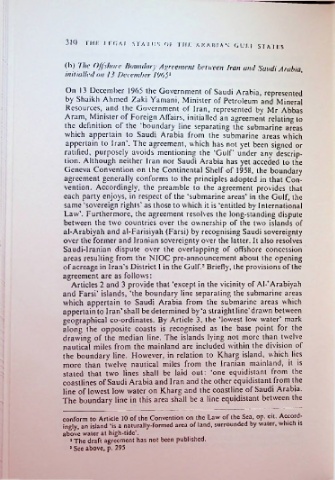Page 374 - The Arabian Gulf States_Neat
P. 374
310 » hi- af. STATUS OP Jin: ARABIAN GULF STATES
(b) The Offshore lioumhry Agreement between Iran and Saudi Arabia
initialled on JJ December l(J65l
On 13 December 1965 the Government of Saudi Arabia, represented
by Shaikh Ahmed Zaki Yamani, Minister of Petroleum and Mineral
Resources, and the Government of Iran, represented by Mr Abbas
Aram, Minister of Foreign Affairs, initialled an agreement relating to
the definition of the ‘boundary line separating the submarine areas
which appertain to Saudi Arabia from the submarine areas which
appertain to Iran’. The agreement, which has not yet been signed or
ratified, purposely avoids mentioning the ‘Gulf’ under any descrip
tion. Although neither Iran nor Saudi Arabia has yet acceded to the
Geneva Convention on the Continental Shelf of 1958, the boundary
agreement generally conforms to the principles adopted in that Con
vention. Accordingly, the preamble to the agreement provides that
each party enjoys, in respect of the ‘submarine areas’ in the Gulf, the
same ‘sovereign rights' as those to which it is ‘entitled by International
Law’. Furthermore, the agreement resolves the long-standing dispute
between the two countries over the ownership of the two islands of
al-Arabiyah and al-Farisiyah (Farsi) by recognising Saudi sovereignty
over the former and Iranian sovereignty over the latter. It also resolves
Saudi-lranian dispute over the overlapping of offshore concession
areas resulting from the NIOC pre-announcement about the opening
of acreage in Iran’s District I in the Gulf.2 Briefly, the provisions of the
agreement are as follows:
Articles 2 and 3 provide that ‘except in the vicinity of Al-'Arabiyah
and Farsi' islands, ‘the boundary line separating the submarine areas
which appertain to Saudi Arabia from the submarine areas which
appertain to Iran’shall be determined by‘a straight line’drawn between
geographical co-ordinates. By Article 3, the ‘lowest low water’ mark
along the opposite coasts is recognised as the base point for the
drawing of the median line. The islands lying not more than twelve
nautical miles from the mainland are included within the division of
the boundary line. However, in relation to Kharg island, which lies
more than twelve nautical miles from the Iranian mainland, it is
stated that two lines shall be laid out: ‘one equidistant from the
coastlines of Saudi Arabia and Iran and the other equidistant from the
line of lowest low water on Kharg and the coastline of Saudi Arabia.
The boundary line in this area shall be a line equidistant between the
conform to Article 10 of the Convention on the Law of the Sea, op. cit. Accord
ingly, an island ‘is a naturally-formed area of land, surrounded by water, which is
above water at high-tide’.
1 The draft agreement has not been published.
2 See above, p. 295

